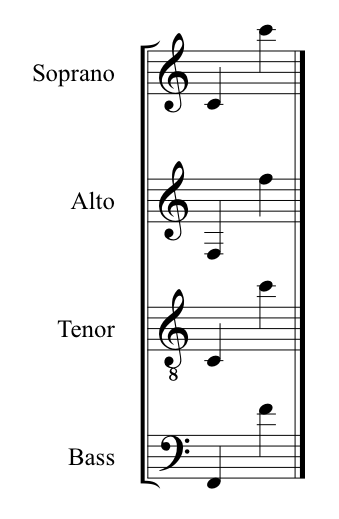Timbre
Timbre (TAM-bur) describes the quality of a sound. In terms of everyday life, it is timbre that allows us to recognize voices on the phone. By recognizing characteristics such as smoothness, nasalness, or tenseness in each person's voice, we instinctively identify familiar voices. When it comes to music, timbre allows us to tell the difference between two instruments that are playing the same pitch at the same volume. Timbre is affected by the size and shape of the instrument, the material from which it is made, and the playing techniques that are used to make sounds. Vocal timbre is mostly determined by a person's physical characteristics such as their gender, height, lung capacity, thickness and length of vocal chords, but can also be affected by age, illness, or lifestyle (smoking, for example).
Aspects of Timbre
Each type of instrument produces a distinctive pattern of loud and soft overtones, or fractional vibrations. These patterns cause an instrument to sound pure (few overtones) or rich and complex (many overtones), thus contributing to the overall timbre.
Attack, the onset of the sound, is another important aspect of timbre. On a string instrument, the sound begins when the bow comes into contact with a string and sets it vibrating. On a reed instrument, the player begins with her tongue touching the reed (preventing it from vibrating), then builds air pressure against the reed, and finally releases the reed so that it can vibrate freely as the air flows through it. These differing techniques cause distinctive patterns of sound at the attack. These patterns are so distinctive that they are critical to our ability to recognize different instruments. When the attack is removed from a sound and we hear only the sustained tone that follows, even trained musicians find it difficult to identify the instrument by ear.
The attack-decay envelope describes how quickly the sound builds to its maximum volume, fades, and ultimately stops. Most instruments do not reach their peak volume instantaneously, but over the course of several milliseconds. The decay of a sound is defined by how long it takes the sound to stop after the original force that caused the vibration has stopped. That is, if you pluck the string of a guitar or press a key on a piano and let it ring, how long does it take the sound to stop? The duration and nature of the attack-decay envelope also contributes to the overall timbre of an instrument.
The purity or impurity of a tone, or the amount and type of noise included in the sound, is another important aspect of timbre. Noise can be caused by breathing or air flow, bow scraping, key clicks, or fingers sliding on strings. These impurities, although often quite subtle, can also help listeners to identify instruments by ear.
Range and Register

Sounding Ranges for Various Instruments
(8va means that the written note should be played one octave higher, 15ma means two octaves higher, and 15mb means two octaves lower)
The range of an instrument or voice consists of the highest and lowest pitch it can reach and all the pitches in between. Here you can see the approximate ranges in notation for several different instruments and the four standard vocal parts.

Sounding Ranges for Standard Voice Parts
The ranges of individual instruments and voices are divided into smaller sections called registers. Sometimes these designations are generic, such as low, middle, or high register, but other times they have special names that come from the history of the instrument or the performance techniques used in that range.
As instruments and voices move between these registers, there are subtle changes in timbre. The low range of the clarinet (the chalumeau register) is known for being rich, full, and dark, whereas the middle range (clarino register) is described as bright and clear and the high range (altissimo register) as piercing and intense. As the clarinet moves higher and higher within its range, the the lower harmonics become less prominent, which is one cause of these timbral variations. Every instrument and voice has similar variations in timbre within different registers.

